While the cryptocurrency markets recently celebrated a 5.5% boost in total capitalization, Ethereum, one of the leading cryptocurrencies, didn’t seem to join the party.
Despite the overall bullish vibes, Ethereum’s performance remained sluggish, failing to break the $3,000 mark, a barrier it hasn’t surpassed for over five days.
This underperformance is even more bleak when compared to Bitcoin, which has outshined Ethereum by a substantial 22% since the dawn of 2024.

Impacts of US economic data on crypto markets
The recent data releases from the U.S. have had a mixed bag of effects on various asset classes, with cryptocurrencies riding a precarious wave. April’s consumer price index, which rose by 3.4% year-over-year, met market predictions and fueled some positive sentiment.
However, the retail sales figures for the same month threw a curveball at investors. Stability in retail sales, contrary to the anticipated 0.4% increase, hinted at potential economic steadiness that might reduce the urgency for further monetary stimulus by the U.S. Federal Reserve.
The Fed’s current stance is to maintain interest rates above 5.25% as a long-term strategy to curb inflation.
However, they might still resort to pumping more money into the economy through measures like purchasing government securities or cutting the discount rate for bank loans.
This injection of liquidity generally boosts investments in scarce assets like stocks, gold, and yes, cryptocurrencies. But this anticipation can turn into a double-edged sword.
As the government issues more debt to fund these monetary expansions, inflation is likely to tick upwards, diluting the immediate gains of asset price increases.
Speculations cause Ethereum’s stagnation
As Ethereum watchers eye the upcoming decision on May 23 by the U.S. Securities and Exchange Commission regarding VanEck’s spot ETH ETF application, the atmosphere is thick with anxiety.
This uncertainty has left traders on edge, leading them to hold off on major moves until the decision is clear. The stakes are high, as approval could propel Ethereum past current resistances, while rejection might trigger a sharp correction.
Insights from Eric Balchunas, a senior ETF analyst at Bloomberg, suggest a slim chance of approval for the spot Ethereum ETF this year, especially due to concerns around products that involve native staking services, which could be classified as securities. This skepticism has permeated the Ethereum derivatives market as well.
In the derivatives realm, Ethereum’s future looks tepid. The futures premium, or basis rate, for Ethereum has hovered around 9%—indicating a mere neutral sentiment among traders.
This rate, stable for the past two weeks, implies a general disinterest or cautious approach from the trading community towards Ethereum, especially concerning the ETF’s approval.
The options market mirrors this neutrality. The balance between call (buy) and put (sell) options remains even, with no significant tilt indicating a bearish or bullish dominance.
Typically, a bearish sentiment would push the 25% delta skew metric above 7%. Conversely, a skew below this figure signals bullish enthusiasm. Neither extreme is currently evident, suggesting a wait-and-watch strategy prevailing among Ethereum investors.
Adding to the complexity, Ethereum’s supply mechanics have recently tipped towards inflation for the first time in 18 months due to a decrease in transaction fees. This shift could further dampen ETH prices, keeping them under the $3,000 threshold.





